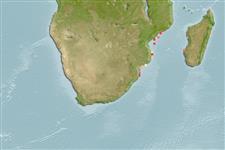>
Eupercaria/misc (Various families in series Eupercaria) >
Sparidae (Porgies)
Etymology: Polysteganus: Greek, polys = a lot of + Greek, stego, stege = covered (Ref. 45335).
More on author: Günther.
Environment: milieu / climate zone / depth range / distribution range
Ökologie
seewasser riff-verbunden; tiefenbereich 20 - 100 m (Ref. 3198). Subtropical; 17°S - 28°S
Western Indian Ocean: known only from Beira, Mozambique to Algoa Bay, South Africa.
Size / Gewicht / Alter
Maturity: Lm ? range ? - ? cm
Max length : 90.0 cm TL Männchen/unbestimmt; (Ref. 3198); common length : 35.0 cm TL Männchen/unbestimmt; (Ref. 3507); max. veröff. Gewicht: 7.8 kg (Ref. 40637)
Rückenflossenstacheln (insgesamt) : 12; Rückenflossenweichstrahlen (insgesamt) : 10; Afterflossenstacheln: 3; Afterflossenweichstrahlen: 8. Small eye, deep preorbital, steep forehead (Ref. 3198).
Occurs in deep offshore reefs ranging from 20 to 100 m. Feeds on large crabs, crayfish, a variety of reef fish and squid. Spawns in winter. Sold fresh (Ref. 3507).
Life cycle and mating behavior
Geschlechtsreife | Fortpflanzung | Ablaichen | Eier | Fecundity | Larven
Smith, J.L.B. and M.M. Smith, 1986. Sparidae. p. 580-594. In M.M. Smith and P.C. Heemstra (eds.) Smiths' sea fishes. Springer-Verlag, Berlin. (Ref. 3198)
IUCN Rote Liste Status (Ref. 130435: Version 2024-1)
Bedrohung für Menschen
Harmless
Nutzung durch Menschen
Fischereien: kommerziell
Tools
Zusatzinformationen
Download XML
Internet Quellen
Estimates based on models
Preferred temperature (Ref.
123201): 23.5 - 26.3, mean 25.3 °C (based on 11 cells).
Phylogenetic diversity index (Ref.
82804): PD
50 = 0.5039 [Uniqueness, from 0.5 = low to 2.0 = high].
Bayesian length-weight: a=0.01778 (0.00976 - 0.03241), b=3.03 (2.88 - 3.18), in cm total length, based on LWR estimates for this species & (Sub)family-body (Ref.
93245).
Trophic level (Ref.
69278): 4.5 ±0.80 se; based on food items.
Widerstandsfähigkeit (Ref.
120179): sehr niedrig, Verdopplung der Population dauert mehr als 14 Jahre. (Preliminary K or Fecundity.).
Fishing Vulnerability (Ref.
59153): High vulnerability (56 of 100).
Nutrients (Ref.
124155): Calcium = 18 [8, 28] mg/100g; Iron = 0.516 [0.257, 1.003] mg/100g; Protein = 20.6 [19.5, 21.8] %; Omega3 = 0.224 [0.129, 0.400] g/100g; Selenium = 18.1 [8.4, 37.2] μg/100g; VitaminA = 63.5 [19.0, 207.2] μg/100g; Zinc = 0.509 [0.332, 0.761] mg/100g (wet weight);
